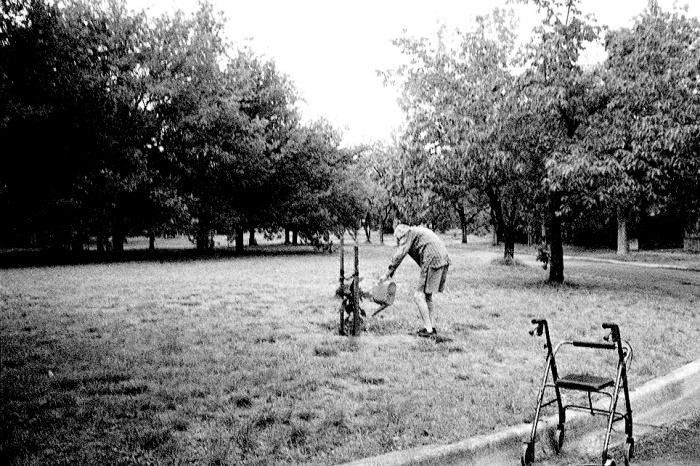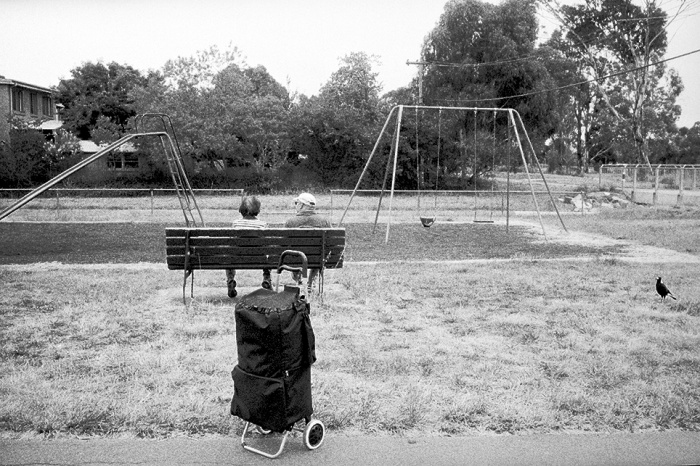French-born Canberra-based photographer Gilbert Herrada’s new exhibition Neighbourhood: People of Lyneham and O’Connor contemplates the many ways in which we occupy, navigate and use private and public space in a neighbourhood, writes Janice Falsone.

Gilbert Herrada, Untitled #30, 2016, inkjet print from photographic negative, 29.7cm x 21cm
Gilbert Herrada’s Neighbourhood is an exercise not only in documentary photography, but also, according to Gilbert, a form of ethnographic narrative. An attempt, that is, to tell the story of a particular group of people in a specific time and place – in this instance, the residents of Lyneham and O’Connor. Gilbert’s ethnography is far from scientific in method, but nonetheless deliberate and considered. It is the result of patient observation and long familiarity with the subject, but the effect is to document a world made up of casual suburban encounters, passing glimpses in driveways and front yards, the kind of record that might be compiled by a curious walker on his or her daily rounds.
Gilbert contemplates the many ways in which we occupy, navigate and use private and public space in a neighbourhood. His candid street photography is restricted to five particular categories – shots of people gardening, getting from a to b, walking pets, doing things with or to their cars, or, of course – it’s Lyneham after, all hanging out at the shops and coming to The Front.
It’s a similar approach to one used by New York architect Michael Sorkin, who for more than fifteen years took an almost daily twenty-minute walk from his apartment in Greenwich Village to his architecture studio in Tribeca. Where Sorkin used what he saw as stimulus for a series of written reflections on urban planning, community, and the relationship between the physical and social worlds of the city1, Gilbert’s photos are more enigmatic, leaving it up to us to complete the story, to provide our own interpretation. Is this a picture of dull suburbia, full of routine gestures and alienated home-owners (most of the photos show only one or two people at most)? is this low density living that would be better replaced by urban infill? Or is this a lively and intriguing place, where people care for their gardens, their animals, each other, where there is space to project one’s own character onto the landscape, to contribute actively to shaping an environment?
Gilbert’s images of people busying themselves in their front yards invite us to consider the peculiar nature of this type of space. The front yard, unlike the backyard (which we spend a lot more time talking about and mythologising) is neither private nor public, but something of both. It is clearly demarcated from the street, yet open to and in most cases entirely visible from the street. It is a stage arranged with hedges, shrubberies, driveways and lawns, on which Lynehamites and O’Connorans spend their weekends shovelling bark chip, raking, pruning, watering and weeding. It is not clear whether the creativity and care invested in these spaces is for the benefit of the onlooker, the passerby looking at the house so nicely framed, or for the resident, whose view of the street is softened by this intermediate zone. Or perhaps it is simply the pleasure of being there and doing it that best explains the effort.

Gilbert Herrada, Untitled #1, 2016, inkjet print from photographic negative, 29.7cm x 21cm
The line between private domain and public realm is blurred even more in Gilbert’s neighbourhood by images of green thumbs applying themselves beyond the boundaries of their front yards, to cultivate the communal land between the footpath and the bitumen, or in community gardens. A beautiful example of this is the first image in this exhibition (Untitled #1) – an image of a father crouched over, tending to the garden bed in the nature strip in front of his house, with his baby perched within reach at the edge of the rockery that frames the garden bed. This expansion of private space into the public realm characterises many of the images within this exhibition.

Gilbert Herrada, Untitled #15, 2016, inkjet print from photographic negative, 29.7cm x 21cm
One image which for me really stands out, and which demonstrates a sense of community ownership of public space, is the image of the elderly gentleman watering a small tree in a park (Untitled #15). His walking frame, which he has left by the kerb at the edge of the image, echoes the supporting stakes holding up the young tree. The act of watering is in one sense a gesture of fraternity – the man recognising another vulnerable organism in need of care – and yet what a gulf there is between them, at opposite ends of life – the young tree destined to outlive the man who cares for it. The suburb will outlive its residents, the community will outlast the individual, the gift of neighbourhood is not only for our own enjoyment but ultimately for others.

Gilbert Herrada, Untitled #51, 2016, inkjet print from photographic negative, 29.7cm x 21cm
Gilbert’s images are not only appealing for their subject matter, but also for their skilful composition and use of photographic technique. A large bearded man sitting at the Lyneham shops looks intently over his shoulder at something or someone outside the frame, while a short man in a hat walks calmly by in front of him (Untitled #51). The meeting (or non-meeting) of these two men is framed masterfully by the patterns of brick and paving. The austere wall of the supermarket becomes a backdrop for a tense contrast. Who are these men? What are they thinking? How many times have we ourselves walked past these very same men without ever wondering what inner life was unfolding right there at the shops?

Gilbert Herrada, Untitled #42, 2016, inkjet print from photographic negative, 29.7cm x 21cm
The couple sitting with their backs to us on the park bench, looking out over the empty playground (Untitled #42). The shopping cart trustingly left in the foreground, while a magpie at the right of the scene looks on opportunistically. The elderly man with polished shoes walking his spotted dog (Untitled #30). Is he scratching his head or using a mobile phone?
The French writer, Georges Perec, in his book Species of Spaces invites us to look at our surroundings in new ways – Force yourself to write down what is of no interest, what is most obvious, most common, most colourless… Make an effort to exhaust the subject, even if that seems grotesque, or pointless, or stupid. You still haven’t looked at anything, you’ve merely picked out what you’ve long ago picked out.2
Gilbert’s film photography, shot on an old Leica — a type of camera synonymous with twentieth-century street photography — goes beyond “picking out” and instead invites us to look again at the world around us.
Neighbourhood is on display at The Front Gallery, Lyneham Canberra, from 14 to 25 April 2016.
Janice Falsone is the Director at PhotoAccess. Janice was opening speaker at Gilbert Herrada’s Neighbourhood exhibition on 14 April 2016.
- Michael Sorkin, 2009. Twenty Minutes in Manhattan. Edition. Reaktion Books.
- Georges Perec, 2008. Species of Spaces and Other Pieces (Penguin Classics). New Ed Edition. Penguin Classics, p50